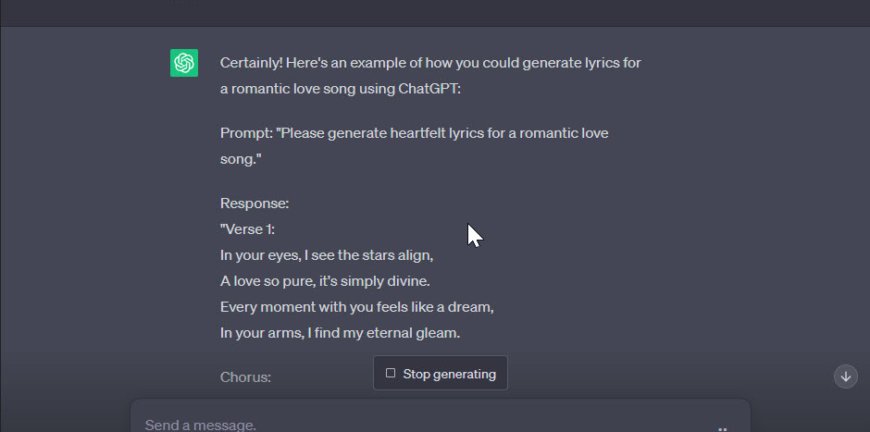
Can ChatGPT make music?
From freestyle raps to love songs and dramatic metal hits, Yes ChatGPT can make music and has become a go-to resource for various tasks. Its prowess in summarizing text and generating information has made it a force to be reckoned with in the world of artificial intelligence (AI). In this article, we’ll dive into the capabilities of ChatGPT in the realm of music composition and shed light on its limitations.
Article Contents
Can ChatGPT Make Music?
Indeed, ChatGPT has the ability to write song lyrics in a matter of seconds. By providing additional prompts and details, the generated lyrics can even have the potential to become a hit. However, it’s important to note that ChatGPT solely relies on text inputs and lacks the capability to work directly with audio files or create melodies. Despite this limitation, ChatGPT showcases an impressive understanding of music theory, allowing it to generate chord progressions for various music styles.
Follow these steps: To create music using ChatGPT OpenAi and Python
- Set up the Environment:
- Install the required dependencies, such as Python and the OpenAI Python library.
- Create a new Python script or open an existing one to interact with ChatGPT.
- Import the Necessary Libraries:
- Import the required libraries, including the OpenAI library, to interact with the ChatGPT model.
- Authenticate and Initialize the Model:
- Set up authentication to access the ChatGPT model. This typically involves providing your OpenAI API credentials.
- Initialize the ChatGPT model by specifying the model name or model ID. For example, you can use “gpt-3.5-turbo” for the latest version.
- Define the Prompt:
- Decide on the type of music or lyrics you want to generate. Prepare a prompt that provides a clear context for the model.
- For example, if you want to generate lyrics for a love song, your prompt could be something like, “Write me romantic lyrics for a love song.”
- Generate Music/Lyrics:
- Use the ChatGPT model to generate the desired music or lyrics by sending a request with the prompt.
- Depending on the library you are using, you may need to specify parameters such as the maximum length of the response or the number of completions to generate.
- Process and Refine the Output:
- Once you receive the generated response from the ChatGPT model, you can process and refine it as needed.
- This may involve removing any unwanted or nonsensical parts, restructuring the lyrics, or adding your personal touch to the composition.
- Iterative Improvement:
- Experiment with different prompts and refine the generated output iteratively.
- You can provide more specific instructions or details to guide the model and achieve the desired results.
- Evaluate and Enhance:
- Evaluate the generated music or lyrics and consider incorporating feedback from others.
- Refine and enhance the output based on your artistic preferences, emotions, and the overall impact you want to create.
- Finalize and Share:
- Once you are satisfied with the generated music or lyrics, finalize the composition.
- You can choose to share it with others, collaborate with musicians, or further develop it into a complete musical piece.
Remember, the quality of the output may vary based on the prompt, model configuration, and training data. It’s important to experiment, iterate, and refine the generated content to achieve the desired artistic expression.
Follow these steps: To create Lyrics and musical ideas using ChatGPT
ChatGPT can generate text-based responses related to music, including lyrics and musical ideas. While it doesn’t have the ability to directly compose or write music in the traditional sense, it can assist in generating creative prompts and suggestions for music composition.
Here are some questions you can ask ChatGPT to generate music-related content:
- Can you provide me with a catchy melody for a pop song?”
- “What are some chord progressions that work well for a jazz composition?”
- “Can you generate lyrics for a romantic love song?”
- “What are some unique rhythms for a dance track?”
- “Suggest harmonies for a rock ballad.”
- “How can I create an atmospheric ambiance in my instrumental piece?”
- “What are some tips for composing a memorable chorus?”
- “Can you suggest instruments that would complement a classical orchestral composition?”
- “What are some common techniques for building tension in a cinematic soundtrack?”
- “Can you provide ideas for a unique and catchy musical hook?”
Remember to experiment with different prompts, provide additional details or constraints, and iterate on the generated responses to refine and shape the music according to your artistic vision.
The Role of ChatGPT in Music Creation:
While some critics argue that AI involvement in music creation erodes authenticity and individualism, there is another perspective to consider. Embracing the use of AI as a digital creativity aid can actually foster the emergence of more art and artists. Even individuals without prior music training can actively contribute and immerse themselves in the music scene with the assistance of AI technologies like ChatGPT.
The Final Verdict on ChatGPT capabilities for creating Music:
ChatGPT undeniably possesses the ability to create music. While its compositions may not rival the intricacies of Beyoncé’s work, ChatGPT can generate chords and lyrics within seconds. By utilizing prompts and additional user-provided information, ChatGPT can further refine its musical output. Nevertheless, it is important to highlight that ChatGPT’s limitations prevent it from creating melodies, and its output remains restricted to text without the capability to share audio files.
Conclusion:
ChatGPT demonstrates remarkable potential in the realm of music composition. While it may not fully replicate the depth and complexity of human creativity, it serves as a valuable tool for generating lyrics and chord progressions. By leveraging the power of AI, artists and enthusiasts can explore new avenues of musical expression. As technology continues to advance, the collaboration between AI and human creativity holds immense possibilities for pushing the boundaries of musical innovation.


